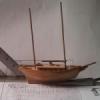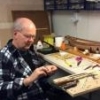MORE HANDBOOKS ARE ON THEIR WAY! We will let you know when they get here.
×
-
Posts
366 -
Joined
-
Last visited
Reputation Activity
-
 steamschooner reacted to Mahuna in Kathryn by Mahuna - FINISHED - 1:32 - Skipjack Based on HAER Drawings
steamschooner reacted to Mahuna in Kathryn by Mahuna - FINISHED - 1:32 - Skipjack Based on HAER Drawings
Part 49 – Kathryn’s Dredge Winder Cont’d
Progress continues on the dredge winder for Kathryn. The last post addressed the manufacture of the winder drums. These are the main components of the winder, but there are many other pieces that need to be made.
The following HAER drawing shows these other components. The clutch assembly is fairly complex, consisting of several different parts. The winder is mounted on I-beams. There are brackets that hold the drums in place, and the drums are encased in protective shells. The shaft for the drive gear reaches from the engine to the front of the winder, and is mounted on a square configuration at the forward face of the winder.
Manufacturing the I-beams was a simple matter of reducing the width of a 3/16 square rod, and then milling both sides to form the I shape.
The cross pieces of the mount were created by cutting shorter pieces to a 45 degree angle at each end, and then soldering strips on the ends to serve as caps. The following photo shows the components of the mounts laid in place but not yet soldered.
The main component of the clutch assembly consists of a barrel shape flattened on the top. The shape was formed on the lathe, and the parting tool was used to cut a separation deep enough for the core of the piece to remain round even after the top is flattened. This allows the parting off of the piece in a later step.
The piece was then moved to the mill and the top of the larger cylinder was flattened.
The piece was then parted from the stock. A small rod was used to prevent the piece from flying off when parted.
The handle of the clutch assembly is connected to the clutch body by a disk that has multiple holes around the outside edge. These disks were created on the rotary table from 3/16” round bar, and were parted off to be .020” thick.
The following photo shows the clutch components described above.
The clutch handle was made from 1/16 x .020 brass strip. The handle needed to be drilled to take a 1/32” shaft that will attach the handle to the clutch. Drilling was done with a sensitive drilling attachment with the following setup.
Weights are attached to the bottom of the clutch handles. These weights were made from 1/8 x .025 stock, and were soldered to the handles using the setup shown in the following photo. The jig was made from Corian.
The following photo shows the handles and weights after final shaping of the weights.
The disk and a 1/32” rod were soldered to the handles.
The tops of the handles incline toward the winder, so the handles needed to be bent. To ensure that both handles were bent at the same place a simple jig was used in the bending.
The following photo shows the clutch components dry-fit to a winder drum.
An additional part is needed for the clutch assembly. There is a small cap that will sit on top of each clutch body. To make these caps, a piece of stock was milled to shape, and then the middle part was rounded using a rotary tool and files. The following photo shows the stock after shaping but before the two required pieces were parted off.
The support for the drive shaft was fairly complex. It was made from 1/8 x .025 brass strip, soldered as a box approximately ¼” square. The forward and rear faces of this support are not full, but are made from some angled pieces.
As can be seen in the above photo, one side has slightly sprung as a result of a solder joint failing. This will be repaired before the support is installed.
Front and rear brackets are needed for mounting the winder drums, and a bracket is needed for holding the drive shaft on the mount shown above. These brackets were made by drilling appropriate holes in a piece of brass strip, then rough milling to reduce most of the excess, and finally by filing the brackets to the proper shape.
The first step in forming the winder’s base was soldering the forward crosspiece to the two runners. A squaring jig was used to ensure that the crosspiece was square.
The following photo shows all of the components for the winder that have been made so far. The protective shells still need to be made, and then assembly can begin.
-
 steamschooner reacted to russ in Captain Roy 1948 by russ - FINISHED - 1/48 scale - POB - Biloxi Lugger
steamschooner reacted to russ in Captain Roy 1948 by russ - FINISHED - 1/48 scale - POB - Biloxi Lugger
Here is some progress on the deck planking. The hatches and pilot house base areas have been closed in and you can see the detail of the planking where it meest the margin plank near the bow. So far so good.
Russ
-
 steamschooner reacted to DBorgens in Skippercraft runabout by DBorgens - 1:16 scale
steamschooner reacted to DBorgens in Skippercraft runabout by DBorgens - 1:16 scale
Catching up. I have finished the anti-fouling paint (actually just red, satin spray paint). Yesterday I set the waterline. I prefer the laser level method as I find it easier to see the line on curved surfaces. It worked out well on my Bluenose. You can just see the laser along the hull. I used tape pointers to identify the line and set the masking tape. In the second picture, two pointers identify where the waterline intersects the strakelet edges. I sprayed the first coat of black this morning so I am updating this log while it dries. What else would I do in a chilly, rainy Monday?
-
 steamschooner reacted to DBorgens in Skippercraft runabout by DBorgens - 1:16 scale
steamschooner reacted to DBorgens in Skippercraft runabout by DBorgens - 1:16 scale
The steering pulleys are laminated thin styrene to make the groove easier. The full size pulleys are 2-1/2 inch diameter. I found some fine beading wire for the steering cable. The wire is .014 in (.36 mm) diameter, 21 strand with a clear coating. Very fine strands indeed. This is almost ¼ inch diameter in scale (the boat uses 1/8 in cable) but it looks right.
The pictures below show the deck installed along with the details added earlier. The throttle and shift cables are 1/32 styrene rod painted black. There is a small step in the deck at the corner of the windshield so I covered the foredeck with thin ply. Some filling and sanding then I can paint the hull.
-
 steamschooner reacted to DBorgens in Skippercraft runabout by DBorgens - 1:16 scale
steamschooner reacted to DBorgens in Skippercraft runabout by DBorgens - 1:16 scale
Bits and Pieces
I made the throttle control by laminating 1/32 sheet and 1/64 plywood. This was the best way to support the levers in position. The first photo shows the slots to hold the throttle at the idle position and the shift lever in neutral. The levers are brass strips with small beads for handles and will be installed later.
The speedometer face was drawn large and printed at a very small scale. I chose the darker one. The photo shows all of the tiny imperfections. Patrick, how do you build in such small scale? My fingers are not that skilled.
Unable to find a commercial steering wheel the right size, I soldered one from brass tubing and sheet. The result is acceptable though not as round as I would like. My ambitions exceed my skills (don’t we all?).
The gray part with wires in the photo is the compass body. I will paint the top black to resemble the dial and will make a small base. I will not even attempt to print the dial, it would be invisible.
-
 steamschooner reacted to russ in Captain Roy 1948 by russ - FINISHED - 1/48 scale - POB - Biloxi Lugger
steamschooner reacted to russ in Captain Roy 1948 by russ - FINISHED - 1/48 scale - POB - Biloxi Lugger
The deck planking begins. The first planks are along the center line. These planks have to be right or it will spoil the appearance of the deck. I am using jigs to represent the footprints of the pilot house and hatches. This will ensure that the deck planks end snugly against the hatch coamings and the base of the pilot house. Doing it this way will allow me to have the coamings and pilot house base sit down into the deck planking, making a snug and seamless fit more likely. I could simply plank the deck and then have the coamings sit on top of the planking. However, that could lead to ugly gaps along the base of the coamings. I am hoping this will make that possibility less likely.
Russ
-
 steamschooner reacted to Nirvana in Bluenose by Nirvana - Model Shipways - Scale 1:64
steamschooner reacted to Nirvana in Bluenose by Nirvana - Model Shipways - Scale 1:64
So I am getting to an end of manufacturing the main rail parts.
Using both the plans and yacht I feel I have got a good fit.
After the last part been cut and trimmed, sanding and pre-stain is next before painting.
I worked from Stem and Stern to get my parts correct.
-
 steamschooner reacted to mtaylor in Licorne 1755 by mtaylor - 3/16" scale - French Frigate - from Hahn plans - Version 2.0 - TERMINATED
steamschooner reacted to mtaylor in Licorne 1755 by mtaylor - 3/16" scale - French Frigate - from Hahn plans - Version 2.0 - TERMINATED
Thanks for the likes and comments. They are deeply appreciated and encouraging.
I finished the planking the interior of the gundeck and have sanded it all pretty smooth. Still needs another pass with the sandpaper, IMO, along with some crack filling. I also need to make some "trim" bits (fiddly) for the cabin. To break the monotony of sanding, I have started work on the gun carriages. I just need to find a good time to start the guns themselves.
Here's the pics as she stands in the shipyard today. I'm running an inventory of eyebolts, rings, and some blocks to see if I have enough to fit out what's needed on this deck as well as the outside hull.
-
 steamschooner reacted to Mirabell61 in Eagle of Algier 1753 by Mirabell61 - FINISHED - 1:48 - Chebec - Nils Langemann
steamschooner reacted to Mirabell61 in Eagle of Algier 1753 by Mirabell61 - FINISHED - 1:48 - Chebec - Nils Langemann
Update :
light guns mounted to the quarter deck balustrade and the bulwarks....
Nils
-
 steamschooner reacted to Omega1234 in SHADOW by Omega1234 - FINISHED - Scale 1/300 - Luxury 60m Mega Yacht
steamschooner reacted to Omega1234 in SHADOW by Omega1234 - FINISHED - Scale 1/300 - Luxury 60m Mega Yacht
Thanks Mark, Nils and Denis for your comments and everyone else for their Likes.
Last night I glued Shadow’s port and starboard garage doors in place, ie in the open position, so that Shadow’s two tenders can be viewed from outside the ship.
I also made two new staircases (currently these are only dry-fiited as they need adjustments) that are situated at the rear of the ship, which give passengers and crew access to the diving platform at the stern.
Lots more work to go, but I’m having fun all the way.
Have a great week, everybody!
Cheers
Patrick
-
 steamschooner got a reaction from Mirabell61 in John Cudahy by steamschooner - FINISHED - 1/4" scale - Steam Tug
steamschooner got a reaction from Mirabell61 in John Cudahy by steamschooner - FINISHED - 1/4" scale - Steam Tug
Here are a couple of shots of my generator motor. I know it's some what simplified but it was fun to build. All the machinery will get painted and after installing I will run small wire to them as supply piping.
-
 steamschooner got a reaction from Mirabell61 in John Cudahy by steamschooner - FINISHED - 1/4" scale - Steam Tug
steamschooner got a reaction from Mirabell61 in John Cudahy by steamschooner - FINISHED - 1/4" scale - Steam Tug
I will be adding some detail that will be little seen. I am going to out fit the engineroom/boiler space with a assortment of gear. This is the beginings of my compound steam engine. Wood items are my master molds, the red items are a couple of finished molds with there master patterns removed. I use a vulcanizing rubber for my molds and use Cerro Cast the actual casting. Some molds will be flat cast where the casting material is just poured in. Other molds will be cast in a centrifugal. The wire on the master forms are for cast inplace venting holes which are needed when centrifugal casting.
-
 steamschooner got a reaction from FriedClams in John Cudahy by steamschooner - FINISHED - 1/4" scale - Steam Tug
steamschooner got a reaction from FriedClams in John Cudahy by steamschooner - FINISHED - 1/4" scale - Steam Tug
It's been awhile since I posted on my build. As some of you know I have been casting parts for my build. These are the latest, some anchors for the fore deck. I made up a master out of brass and copper. Made a vulcanized rubber mold to fit a tray a friend made for me. Spun up some anchors and added a cross arm made from copper wire with a small copper ring soldered on for a stop along with a couple small blobs of solder for the balls on the ends. Lightly sandblasted and drilled for arm, chain ring with a little color added.
-
 steamschooner got a reaction from Mirabell61 in John Cudahy by steamschooner - FINISHED - 1/4" scale - Steam Tug
steamschooner got a reaction from Mirabell61 in John Cudahy by steamschooner - FINISHED - 1/4" scale - Steam Tug
Patrick, Not sure whats next I have some ideas. Maybe finish up one I have on the shelf.
-
 steamschooner got a reaction from druxey in John Cudahy by steamschooner - FINISHED - 1/4" scale - Steam Tug
steamschooner got a reaction from druxey in John Cudahy by steamschooner - FINISHED - 1/4" scale - Steam Tug
It's been awhile since I posted on my build. As some of you know I have been casting parts for my build. These are the latest, some anchors for the fore deck. I made up a master out of brass and copper. Made a vulcanized rubber mold to fit a tray a friend made for me. Spun up some anchors and added a cross arm made from copper wire with a small copper ring soldered on for a stop along with a couple small blobs of solder for the balls on the ends. Lightly sandblasted and drilled for arm, chain ring with a little color added.
-
 steamschooner got a reaction from cog in John Cudahy by steamschooner - FINISHED - 1/4" scale - Steam Tug
steamschooner got a reaction from cog in John Cudahy by steamschooner - FINISHED - 1/4" scale - Steam Tug
It's been awhile since I posted on my build. As some of you know I have been casting parts for my build. These are the latest, some anchors for the fore deck. I made up a master out of brass and copper. Made a vulcanized rubber mold to fit a tray a friend made for me. Spun up some anchors and added a cross arm made from copper wire with a small copper ring soldered on for a stop along with a couple small blobs of solder for the balls on the ends. Lightly sandblasted and drilled for arm, chain ring with a little color added.
-
 steamschooner got a reaction from popeye the sailor in Arabia 1856 by Cathead - FINISHED - Scale 1:64 - sidewheel riverboat from the Missouri River, USA
steamschooner got a reaction from popeye the sailor in Arabia 1856 by Cathead - FINISHED - Scale 1:64 - sidewheel riverboat from the Missouri River, USA
Eric, How do you plan to form the transition at the bow? Will the planking butt together on the center of the keel? or will there be a plank that runs the length of the keel? (which you can see in the recovered stern, tiller photo ) I wonder if in real construction if they used chine logs at the point where the side planking meet the flat bottom planking. Putting some blocking between bulkheads, or moving the ones there will give you some backing for those drop planks.
At some point in the future I hope to build a stern wheeler from this area so I follow along.
-
 steamschooner reacted to Wintergreen in Kågen by Wintergreen - FINISHED - 1:30 - Swedish clinker-built cog work boat - SMALL
steamschooner reacted to Wintergreen in Kågen by Wintergreen - FINISHED - 1:30 - Swedish clinker-built cog work boat - SMALL
As per requested, the day was spent in the small ship yard ;-)
What did master accomplish?
Some much needed clean up of some rubbish in the corners of the shop.
Assembled the keel, stem and stern.
Managed a decent tapering of the structure.
And also something to be not so overly proud of, though I thing it happens to all of us...
For the assembly I started with the fore knee and glued it to the keel. Then I faired the surface that faced the stem. My template was faired alongside this to get angles of stem and stern fairly close to spec.
The aft part then, sternpost and knee glued together. Some minor adjustments and it was glued to the keel.
Drilling for bolts were done on freehand (which can clearly be seen in pic 1) with my bulky Dremel.
Note to self: Save up for a Proxxon multitool and drilling station.
Tapering of the structure was accomplished with another annealed mat knife blade.
Sometime during the day I recognized that my floor was a mess so I wiped. In hindsight I would have benefited from looking if any of the pieces had gone astray before I wiped the floor.
Find the anomaly...
Note to self 2: Keep small parts contained in something (anything!)
Apart from that minor setback I'm fairly satisfied with the day.
Til next time, ta!
-
 steamschooner got a reaction from mtaylor in SS Maaninka by Moxis - FINISHED - 1/25 scale - Lake steamer
steamschooner got a reaction from mtaylor in SS Maaninka by Moxis - FINISHED - 1/25 scale - Lake steamer
Moxis. Are two decks and cabins going to be removable as one piece to get at the gear in the hull? The deck looks very nice!
-
 steamschooner got a reaction from mtaylor in Arabia 1856 by Cathead - FINISHED - Scale 1:64 - sidewheel riverboat from the Missouri River, USA
steamschooner got a reaction from mtaylor in Arabia 1856 by Cathead - FINISHED - Scale 1:64 - sidewheel riverboat from the Missouri River, USA
Eric, How do you plan to form the transition at the bow? Will the planking butt together on the center of the keel? or will there be a plank that runs the length of the keel? (which you can see in the recovered stern, tiller photo ) I wonder if in real construction if they used chine logs at the point where the side planking meet the flat bottom planking. Putting some blocking between bulkheads, or moving the ones there will give you some backing for those drop planks.
At some point in the future I hope to build a stern wheeler from this area so I follow along.
-
 steamschooner got a reaction from Canute in Arabia 1856 by Cathead - FINISHED - Scale 1:64 - sidewheel riverboat from the Missouri River, USA
steamschooner got a reaction from Canute in Arabia 1856 by Cathead - FINISHED - Scale 1:64 - sidewheel riverboat from the Missouri River, USA
Eric, How do you plan to form the transition at the bow? Will the planking butt together on the center of the keel? or will there be a plank that runs the length of the keel? (which you can see in the recovered stern, tiller photo ) I wonder if in real construction if they used chine logs at the point where the side planking meet the flat bottom planking. Putting some blocking between bulkheads, or moving the ones there will give you some backing for those drop planks.
At some point in the future I hope to build a stern wheeler from this area so I follow along.
-
 steamschooner reacted to Mirabell61 in Eagle of Algier 1753 by Mirabell61 - FINISHED - 1:48 - Chebec - Nils Langemann
steamschooner reacted to Mirabell61 in Eagle of Algier 1753 by Mirabell61 - FINISHED - 1:48 - Chebec - Nils Langemann
Thanks very much Keith,
I completed the pumps today, mounted discharge tubes for getting water in direction of gratings and away from the operators feet. Also started with the bits at fore- and main mast. The horizontal members are dry fitted in in order to get the correct allignment.
Nils
-
 steamschooner reacted to Mirabell61 in Eagle of Algier 1753 by Mirabell61 - FINISHED - 1:48 - Chebec - Nils Langemann
steamschooner reacted to Mirabell61 in Eagle of Algier 1753 by Mirabell61 - FINISHED - 1:48 - Chebec - Nils Langemann
Hi Piet,
Sorry, I must apologize for not pushing out a seperate log, as the pinnace was somehow a "side build" over the months last year, and there was a time when I thought to scrap it, because so fiddely, did`nt think it was worth a log, and if it would ever work out as intended...... , so it went to the shelf.... Besides That I was so much engaged with the completion of my KWdG, and then came the preperation phase of the Chebec.....
I have here a comparison of the ship sizes, here my HMS Pegasus 1:64 in the background, total length appr. 800 mm and the Chebec EOA with 900 mm over all, but in scale 1:48
Nils
due to the difference in model scales the actual smaller Chebec wih dummy bow sprit appears to be much longer
-
 steamschooner got a reaction from Moxis in SS Maaninka by Moxis - FINISHED - 1/25 scale - Lake steamer
steamschooner got a reaction from Moxis in SS Maaninka by Moxis - FINISHED - 1/25 scale - Lake steamer
Moxis. Are two decks and cabins going to be removable as one piece to get at the gear in the hull? The deck looks very nice!
-
 steamschooner reacted to russ in Captain Roy 1948 by russ - FINISHED - 1/48 scale - POB - Biloxi Lugger
steamschooner reacted to russ in Captain Roy 1948 by russ - FINISHED - 1/48 scale - POB - Biloxi Lugger
Well, I finally have some slight progress to report the last couple of days. What with the holidays and then the bitterly cold weather we have had the last couple of weeks, it has been difficult to get any shop time. Here, I have the large rub rail on the port side and the chain plates installed. In the next couple of days I will get the starboard chain plates installed and then I can do some painting.
Russ









